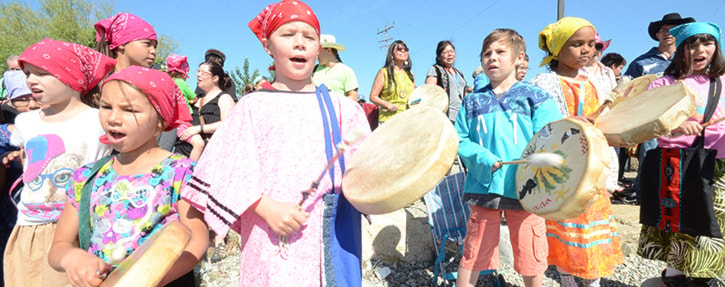Life journeys began on two fronts this week along the shores of the dark, swift-moving waters of the Okanagan River Channel.
Over 200 young students from valley indigenous cultural schools released thousands of sockeye salmon fry, many of which they had raised themselves from eggs, into the waterway on the first leg of their migration to the Pacific Ocean.
“The children here are an important part of the ceremony because this is their future, this is what they’re going to inherit from us so this is a big part of their journey too,” said executive director Pauline Terbasket of the Okanagan Alliance (ONA). “They (children) are going to witness how important it is to have a relationship with the land and the resources and that’s exciting for me.
“This is a community ceremony. “It’s a place we can come together as people to just pause in our busy lives and say, ‘this is important.’”
Held in conjunction with the ongoing work of ONA fisheries department to return the salmon to their traditional numbers and habitat, the day has become an annual celebration of the fish species that was so heavily relied upon in the past by aboriginal peoples. The release of the salmon was extra special for members of the Penticton Indian Band because throughout the week they released the first fry from the state-of-the-art Kł cpə̓ lk stim̓ Hatchery which opened on the reserve last fall.
“This is very significant for us and we’ve broken a record for the number of fry we released this year, 1.6 million,” said PIB Chief Jonathan Kruger, who was at the site May 20 for the special event. “The most we ever released was 1.2 million and our goal is to do five million a year. We’re still working on it but I’m confident our numbers are going to get bigger down the road.
“Last year we had 410,000 salmon come back and our goal one day is to bring over a million back to Okanagan Lake, and see them in Mission creek and all those tributaries throughout the Okanagan.”
The dam at the south end of Okanagan Lake currently prevents that, however, changes are being looked.
According to Terbasket, the critical aspect of putting the children at the forefront of the work to bring the sockeye back is giving them the understanding of what will be they will have to do in the years ahead.
“After all, they will one day be the caretakers and the stewards of this land,” she said.
